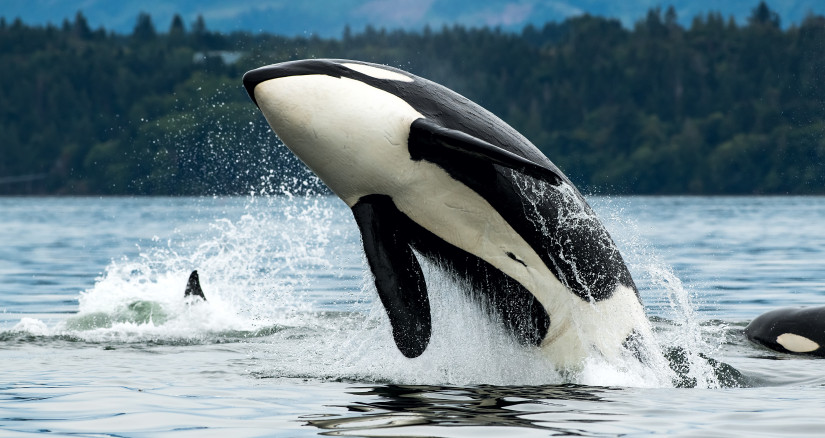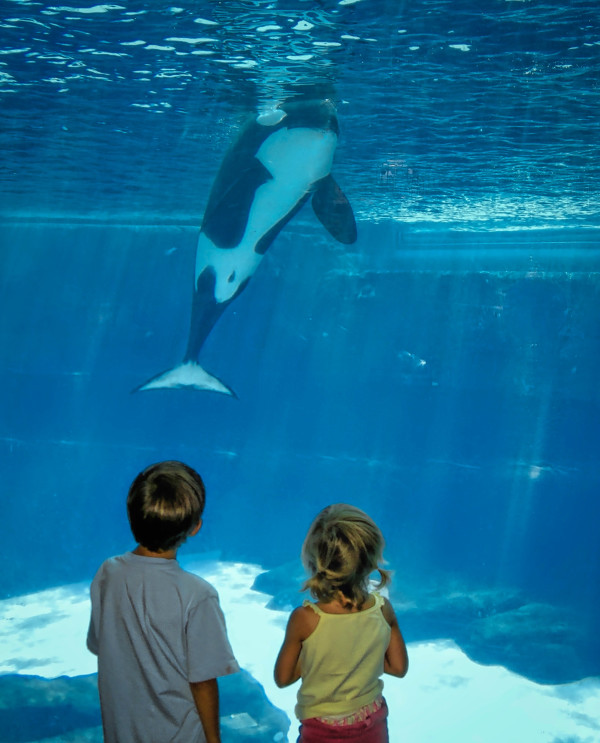
Free Willy: 2025 Edition
A viral video has recently surfaced depicting two orcas, Wikie and Keijo, languishing in what can only be described as a less-than-chic, algae-tinged pool at the now-shuttered Marineland Antibes in France. Once a bustling entertainment venue, this aquatic abode has become the center of a swirling vortex of concern for these majestic marine mammals.
According to reports, two orcas and twelve dolphins have been stranded in the abandoned marine park. France, in a commendable stride toward animal welfare, passed a law in 2021 banning marine mammal shows by December 2026, and has since stopped allowing captive marine mammals in France’s largest marine park, Marineland Antibes, which closed in January 2025. Now, Wikie and Keijo, born into this concrete ocean, are in a watery limbo.

Photo by TonyTheTigersSon
Why Can’t We Just Free Willy?
While most can agree that humane treatment of animals is a basic necessity, a deeper question comes into play: “Where do these marine mammals go after parks are shut down?” For better or worse, the open ocean isn’t on the list of available locations for these animals. The argument of “will they survive?” is dependent on the rehabilitation of said animals. Marine mammals must check three major boxes before they are considered for release to the wild:
- They must be healthy.
- They must be able to feed themselves/hunt.
- They must be free of behaviors that could risk their long-term survival in the wild, such as approaching humans in search of food.
However, this all requires rehabilitation and sometimes years of conditioning them to the wild.
Born in captivity, Wikie and Keijo are not equipped for life in the wild. Releasing them into the vast ocean would be akin to dropping someone who has never seen the ocean in the middle of the Atlantic with a vague map and a "good luck!" Their survival hinges on human intervention, and searching for a suitable new home is all the more critical.
Scouring for Sanctuaries
Animal rights groups, with the unwavering conviction of those who have seen Free Willy one too many times, are advocating for a whale sanctuary. The Whale Sanctuary Project in Nova Scotia has thrown its hat in the ring, despite a previous dismissal from French authorities. Adding star power to the cause, environmental luminaries like Dr. Jane Goodall, Dr. Sylvia Earle, and Jean-Michel Cousteau penned a letter endorsing the Nova Scotia option.
The longer-term vision, it seems, involves establishing marine sanctuaries—semi-wild havens where orcas and dolphins can live safely with more space and autonomy. The estimated annual cost is $2.2 million to 3.3 million, which might seem steep, but can one really put a price on orca happiness? Perhaps a crowdfunding campaign with a catchy slogan like "Save the Whales (Again!)" is in order.
After rejecting the offer to send the marine mammals to Seaworld Japan due to what was considered poor living conditions, Marineland Antibes park management sought to transfer the orcas and a dozen dolphins to Spanish parks. However, Spanish authorities stopped the transaction last minute after deeming the tanks unfit.

Photo by Image-Source
Where Does This Leave the Marine Mammals Now?
The French government, while acknowledging the concerns, assures everyone that the animals are being housed in "good conditions" while "alternative solutions" are sought. Enter Canada-based NGO TideBreakers, armed with drone footage and a healthy dose of digital activism. Their social media post painted a grim picture of a "crumbling, decrepit tank."
Park management, perhaps feeling the heat, countered that the algae was merely a seasonal "glow-up" (their words), harmless, and are regularly scrubbed away. A former manager even chimed in, recalling similar verdant hues in press photos from yesteryear. Still, the court of public opinion, fueled by the circulating video, seems less than convinced by this aquatic aesthetic defense.
Meanwhile, NGOs like One Voice and Sea Shepherd are clamoring for an onsite inspection. After all, seeing is believing, especially when it comes to potentially distressed orcas and questionable algae blooms.
Wikie and Keijo, under adequate conditions, could potentially live for decades. The clock is ticking, and the world is watching, hoping that these intelligent creatures will find a sanctuary before December 2026, where they can finally experience a life that, while not entirely wild, is at least a significant upgrade from a verdant concrete enclosure. One can only hope that the "alternative solutions" being explored are less about bureaucratic hurdles and more about the well-being of these magnificent animals. After all, nobody wants a sequel titled "Orca Sadness."
Follow us on LinkedIn for the latest updates on all things happening here at BSM Partners.
About the Author
Dr. Stephanie Clark is a board-certified companion animal nutritionist, veterinary nurse and nutrition specialist, a pet owner, and a mother who had a baby during the formula shortage. She has spent the past almost two decades dedicating her career to the welfare of pets, livestock, and wildlife. She currently provides nutritional consultations for veterinary clinics and works in the pet food industry.
This content is the property of BSM Partners. Reproduction or retransmission or repurposing of any portion of this content is expressly prohibited without the approval of BSM Partners and is governed by the terms and conditions explained here.